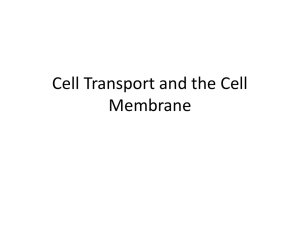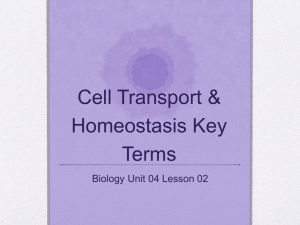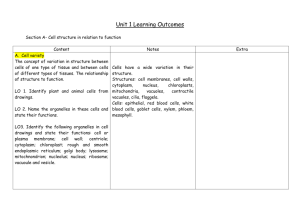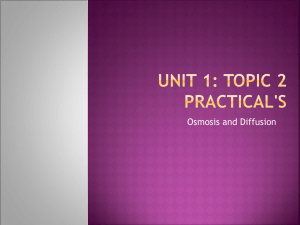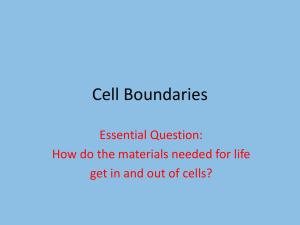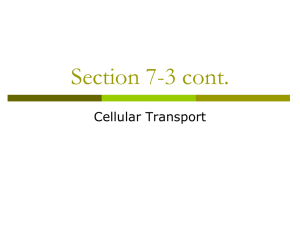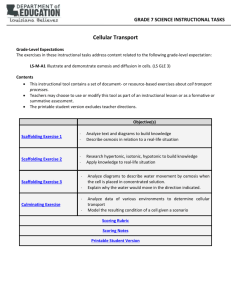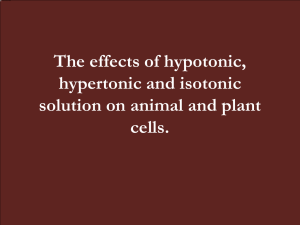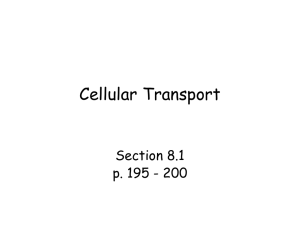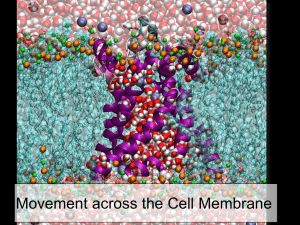Cellular Transport & Cell Cycle: Osmosis, Active & Passive
advertisement
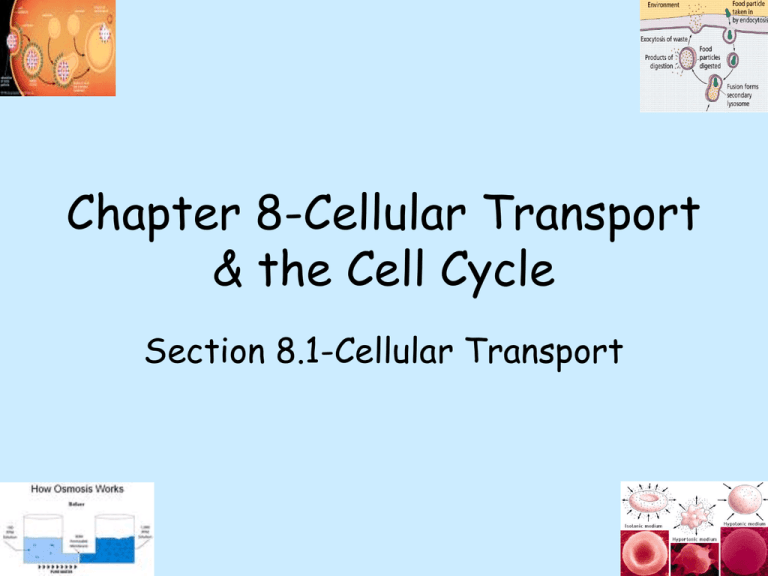
Chapter 8-Cellular Transport & the Cell Cycle Section 8.1-Cellular Transport • • • • Osmosis: Diffusion of Water Plasma membrane can act as a pump or a dam for water soluble molecules Plasma membrane doesn’t limit the diffusion of water Diffusion-def-pg.194- the movement of particles from an area of higher concentration to an area of lower concentration. Osmosis-def-pg194-the diffusion of water across a selectively permeable membrane • Regulating the water flow through the plasma membrane is an imp factor in maintaining homeostasis within the cell What controls osmosis? • • Concentration gradient is one factor that controls osmosis Concentration gradient-def-pg196the unequal distribution of particles • • How osmosis affects cells? Remember that cells are subject to osmosis because they are surrounded by water solutions 3 types of solutions: 1. 2. 3. Isotonic solution Hypotonic solution Hypertonic solution How osmosis affects cells? A. Cells in an isotonic solution • Isotonic solution-def-pg196-the concentration of dissolved substances in the solution is the same as the concentration of dissolved substances inside the cell • • Fig 8.2 this also means that the concentration of water in the solution is the same as the concentration of water inside the cell. Results-cells in an isotonic soln experience osmosis but because the concentrations of water are both the same inside the cell as outside the cells keep their shape. How osmosis affects cells? B. Cells in a hypotonic solution • • Hypotonic solution-def-pg.196- the concentration of dissolved substances is lower in the solution outside the cell than the concentration inside the cell – this means more water outside the cell than inside – Ex/ Animal (Red blood cells) cells may not stand the increased internal pressure and burst Ex/Plant cells- contain a rigid cell wall that supports the cell and it won’t burst in a hypotonic soln-rather the cells will get firm Ex/ grocery stores & fruit & water moisture Results-cells in a hypotonic soln will swell & the internal pressure increases – – Fig 8.3 C. How osmosis affects cells? Cells in a hypertonic solution • Hypertonic solution-def-pg196- the concentration of dissolved substances outside the cell is higher than the concentration inside the cell – • Results- this means water is flowing out of the cell due to osmosis – – Fig 8.4 This means that there is more water inside the cell than outside Ex/ Animal (red blood cells) cells- in a hypertonic soln will shrivel up because of the decreased pressure in the cells Ex/Plant Cells-in a hypertonic soln the cells will lose water, mainly from the central vacuole & cytoplasm & cell membrane will shrink from the cell wall-explains wilting Passive Transport – • Passive transport-def-pg.198-the movement of particles across the membrane without use of energy. Passive transport by proteins • • – – Facilitated diffusion-def-pg.198-passive transport of materials across the membrane using transport proteins Types of transport proteins: Channel proteins- transport proteins that form channels that allow specific molecules to flow through the plasma membrane, this movement happens with the concentration gradient & doesn’t require any energy from the cell Carrier proteins-another type of transport protein, that changes shape to allow a substance to pass through the plasma membrane, this movement happens with the concentration gradient & doesn’t require any energy from the cell Passive Transport Active Transport • • • Active transport-def-pg.199-the movement of materials through a membrane against a concentration gradient & it requires energy from the cell Allows for particle movement into or out of a cell against a concentration gradient Active transport is required for a cell to maintain homeostasis 1. How active transport occurs A transport protein (carrier protein) binds with a particle of the substance to be transported. » Each carrier protein has a shape to fit a specific molecule or ion 2. When the proper molecule binds w/the protein, chemical energy allows the cell to change the shape of the carrier protein so that the particle to be moved is released on the other side of the membrane 3. Once particle is released the protein’s original shape is restore Transport of Large Particles • – – – – • • – – Endocytosis-def-pg.200-the process by which a cell surrounds and takes in material from its environment. During endocytosis material doesn’t pass directly through the cell membrane How endocytosis works? Material is engulfed & enclosed by a portion of the cell’s plasma membrane Portion of the membrane breaks away & the resulting vacuole with the material moves to the inside of cell See fig 8.7 Exocytosis-def-pg.200-the expulsion or secretion of materials from a cell. 1. 2. Cells use this: to get rid of waste secrete substances like hormones produced by the cell Both endocytosis & exocytosis are types of active transport & require energy from the cells
